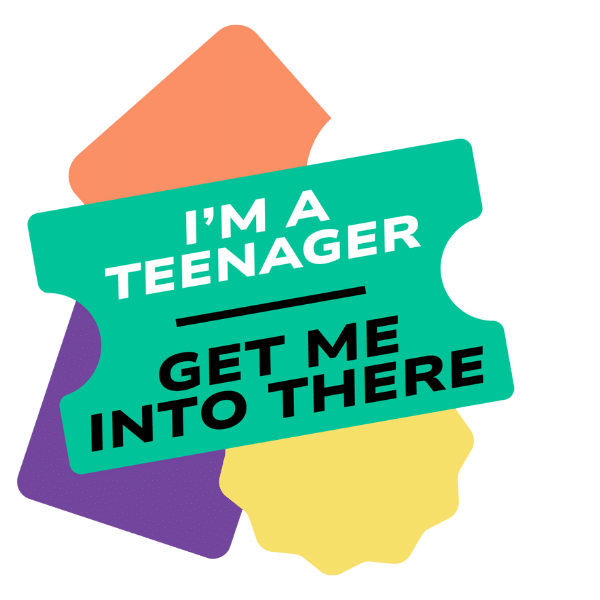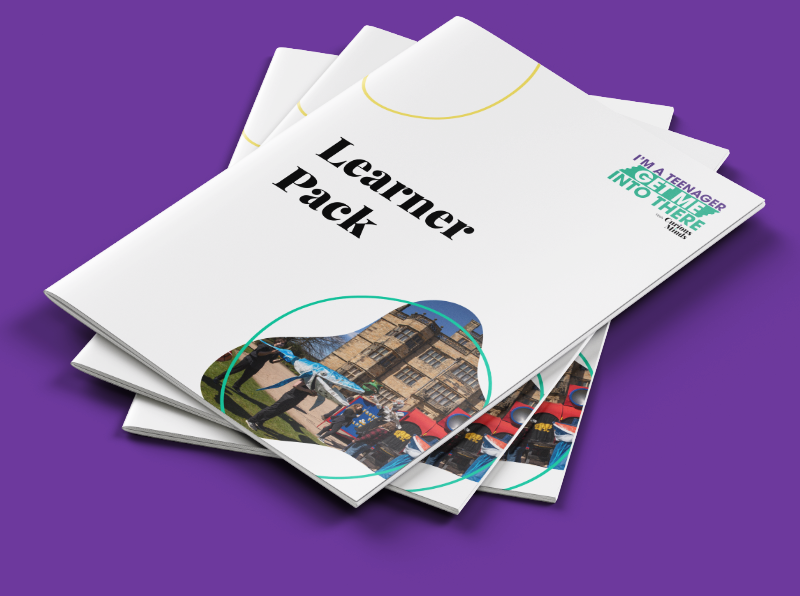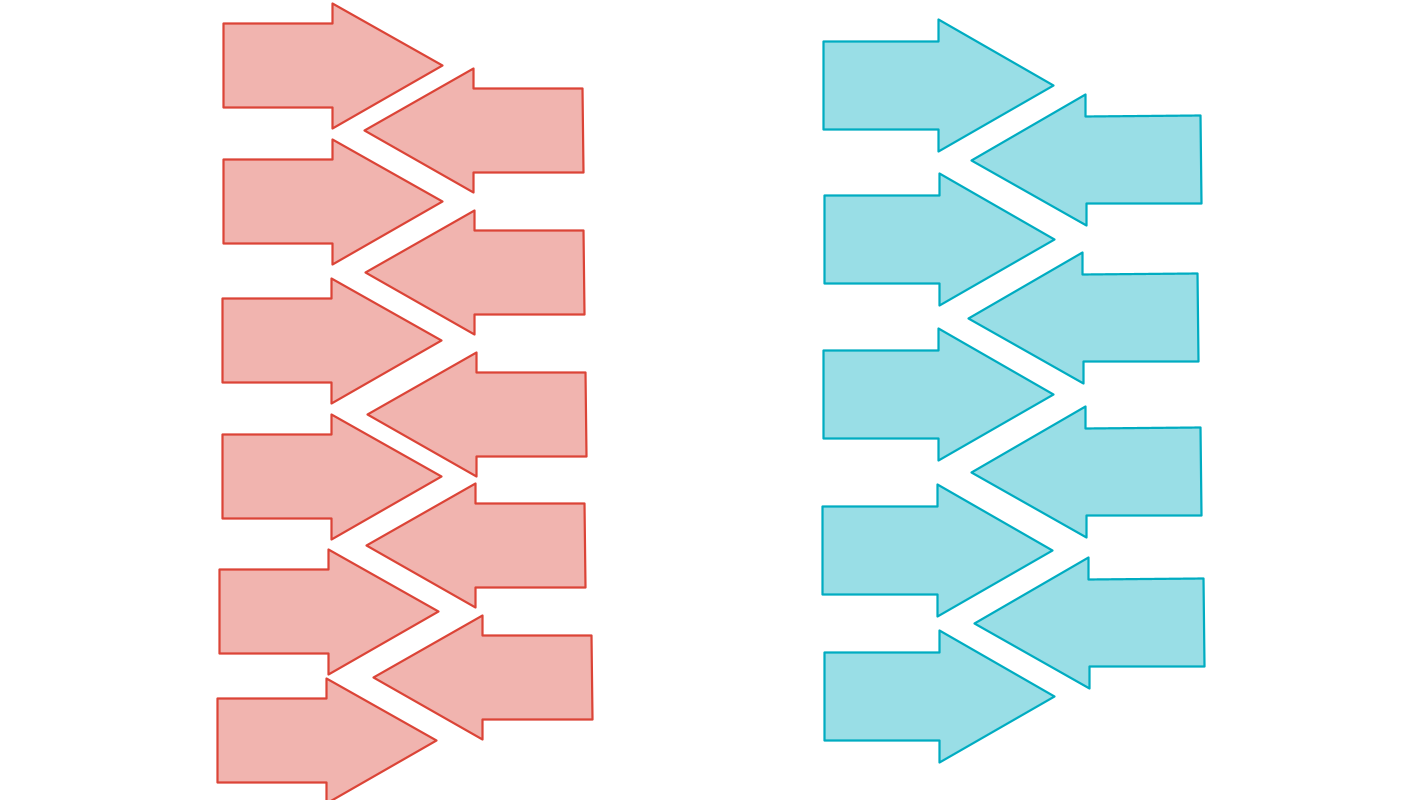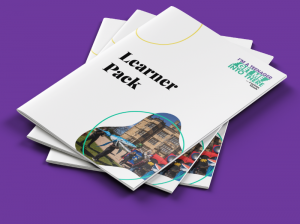
Red Zone / Blue Zone
This module introduces a helpful tool for identifying and changing the visible and invisible barriers in your venue that may make younger visitors feel uncomfortable or unwelcome. These reflective exercises will help you see your venue through young people’s eyes.
Aims

1.
Understand what is meant by Red/Blue Zone behaviour

2.
Think about how language can trigger Red/Blue Zone behaviour

3.
Consider what could be Red/Blue Zone triggers in your cultural venue
Intro
We’ve adopted the concept of Red Zone/Blue Zone behaviour from leadership experts Andrew Mowat, John Corrigan and Doug Long’s book ‘The Success Zone’. The book is not focused on young people but introduces an approach that helps us understand people’s behaviour, particularly when it seems irrational and over-emotional.
You can find out more about The Success Zone here..
As we explored in module 4, teenagers’ brains are still developing. In particular the pre-frontal cortex, which is linked to ‘rational’ behaviour, considering long-term consequences of actions and empathising with others, is not yet fully developed until our early 20’s. When we are considering how emotions and behaviours are triggered by being in the red or blue zone in this module, we should keep in mind how this is further heightened for young people.
Activity 1
TheRedZone
Think of a time when you have been overcome with anger or fear, or felt uncomfortable in a situation, to the extent that it has affected your ability to make calm, rational decisions. This is the feeling we will call the Red Zone.
Here are a few examples:
You’re driving and another car does something dangerous that could put you and your passengers at risk – this might cause you to become furious and shout at the other driver, even though they can’t hear you
You are in a waiting room for an appointment that is already five minutes late. You see other people in the room being called in for their appointments while you are still waiting, with no explanation. You feel that you are being ignored, or have been forgotten, which makes you feel increasingly uncomfortable
You are on a train and a ticket inspector checks your ticket. They tell you that your ticket is not valid for the service you are on and that you will have to pay a fine. You don’t understand why the ticket you bought isn’t valid but the inspector doesn’t believe your explanation. You feel you are being treated unfairly, or being picked on, and that the inspector isn’t listening to you.
In each of these examples, our behaviour is increasingly controlled by the reptilian and mammalian parts of our brain. This means we are more likely to act instinctively, with a focus on survival, and without thinking about the consequences of our actions. We are less likely to act with empathy for other people or think about how our actions may affect others.
Being in the red zone leads can trigger angry outbursts or becoming completely silent and withdrawn. We sometimes describe this as fight or flight behaviour, because we are acting from a defensive survival instinct humans share with lots of animals. For more information on human tendency to ‘fight, flight, flock or freeze’ watch this film:
- Fight – reacting to a situation with anger, leading to conflict
- Flight – leaving a situation as quickly as you can to avoid or escape what is happening
- Flock – finding other people in a similar situation and acting as a group for support or protection
- Freeze – being unable to react at all, becoming unresponsive, not moving or speaking
Each of these reactions is a protective survival instinct in response to a perceived threat to our safety – although it is often not the most productive way to respond. Road rage in response to another dangerous driver can lead to you making mistakes; freezing or quickly leaving a situation where you feel you are being treated unfairly can lead to more problems in the future or make it impossible to resolve an issue. The Red Zone can also be a chain reaction – if you see someone else in their Red Zone, it might trigger yours, or you might trigger someone else.
It is important to recognise, however, that being in the Red Zone can be helpful in an appropriate situation – acting on instinct can help us navigate genuinely dangerous situations quickly and keep us safe.
Think of a time you were in the Red Zone:
- What triggered it?
- What did you feel?
- What did this make you do?
- Could you have done anything differently?
- Could other people in the situation have done anything differently?

Get your Learners Pack here
TheBlueZone
Being in the Blue Zone is when we are at our most focused and engaged. It could involve being completely immersed in a task or activity or feeling particularly connected to and supported by people we are collaborating with.
This could be:
Actors on stage during a performance of a play – where each of them is entirely focused on their work and the character they are playing and how they interact with the other actors
A teacher leading a lesson about a subject they are particularly passionate about. Their explanations and activities completely engage their students, who are excited about what they are learning – everyone is in their Blue Zone here!
A friend comes to you with a problem – by talking it through you are able to collaboratively come up with a solution and your friend leaves feeling much better, and you feel you have been useful in helping them
Being in the Blue Zone means your decisions are being controlled primarily by the human part of the brain, including the prefrontal cortex. This involves taking into consideration long-term consequences to your actions and empathy for other people, as well as a greater understanding of the self and others. It is what drives imagination and creativity and can be based on a moral code.
Think of a time you were in the Blue Zone:
- What triggered it?
- What did you feel?
- What did this make you do?
- How did this impact other people around you?
- Did this have any long-term effects on you or others?
You are more likely to enter the Blue Zone if you feel comfortable, safe and supported. In many ways, you could see your venue existing as a space to help people enter their Blue Zone. Whatever form of art, culture or heritage your venue features, you want visitors to feel engaged, happy and inspired.
For young people, who may be visiting your venue for the first time, they are more likely to feel nervous, uncertain and out of place. Keep in mind, too, that teenagers’ prefrontal cortex is still developing – meaning they are often quicker to enter the Red Zone if they feel unwelcome, scared or threatened. This means, for young people to have a positive experience where they may find themselves in their Blue Zone it is even more important to actively ensure they feel welcome and engaged in your venue.

Get your Learners Pack here
Activity 2
Our Red and Blue Zones can be triggered by a range of different feelings and situations.
In your Learners Journal sort these examples into Red and Blue Zones.

Unfairness
Belonging
Clarity & certainty
Being listened to
Guilt
Not being listened to
Unconditional respect
Generosity
Uncertainty
Lack of control
Fear & anxiety
Safety
Rejection/being left
Being told what to do
Being judged
Sarcasm
Once you have sorted these triggers into Red and Blue Zone, choose 3 from each that you have either experienced yourself, or that you have observed other people experience. It doesn’t have to be young people, or in your venue, but you might decide to pick examples that relate to those things!
We can think of Blue Zone triggers as engaging. In your venue, these are things that draw visitors in, get them interested or excited in what you are presenting, and make them want to come back for more.
Red Zone triggers can be thought of as enraging. They make visitors to your venue feel unwelcome, disengaged and even angry, scared or upset. They would not make them want to return.

If a young visitor on their first independent visit to a venue like yours has a red zone experience, they are not only unlikely to return. They may decide they are no longer interested in the cultural experience your venue represents. Our experience shows that a single negative experience can not only turn a young person off a single venue, such as a museum, it can lead to them deciding they don’t like ANY museums. Negative perceptions formed this way are not only pervasive, they can be permanent or extremely hard to change.
If they have a blue zone experience at your venue, not only are they likely to return, but are more likely to consider the art/culture/heritage form you represent to be something they are interested in exploring further. They may even decide to pursue it in their future studies or work.
Activity 3
Think about a single area of your venue – it could be the entrance hall, a particular gallery or event space, or even outside the front of your venue.
Try to identify five things in this area that are engaging to young visitors. What things will get them into their Blue Zone and feel welcome, engaged and excited by the space? Which Blue Zone triggers do these things encourage?
Now try to think of five things that could be enraging to young visitors. Is there anything that could be confusing, isolating or uncomfortable? Which Red Zone triggers do they cause visitors to feel?
Make a list in your learners’ pack. Consider sharing this with colleagues or senior leaders at your venue – discuss how you might make positive changes to reduce the impact of any Red Zone triggers.
Get your Learners Pack here

Key Learning
In your learning journal please reflect on what you have learnt today and how you could put this into action in your venue.

Get your Learners Pack here
And Finally
How are you going to share your learning with your colleagues? Your visitors?
Did you have any lightbulb moments?
Write down one small thing you are going to do as a result of this module
Write one bigger thing you are going to do as a result of this module
Further reading
Andrew Mowat on The Success Zone